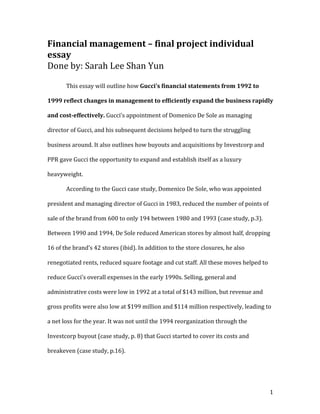
Financial management - final project individual essay
- 1. 1 Financial management – final project individual essay Done by: Sarah Lee Shan Yun This essay will outline how Gucci’s financial statements from 1992 to 1999 reflect changes in management to efficiently expand the business rapidly and cost-‐effectively. Gucci’s appointment of Domenico De Sole as managing director of Gucci, and his subsequent decisions helped to turn the struggling business around. It also outlines how buyouts and acquisitions by Investcorp and PPR gave Gucci the opportunity to expand and establish itself as a luxury heavyweight. According to the Gucci case study, Domenico De Sole, who was appointed president and managing director of Gucci in 1983, reduced the number of points of sale of the brand from 600 to only 194 between 1980 and 1993 (case study, p.3). Between 1990 and 1994, De Sole reduced American stores by almost half, dropping 16 of the brand’s 42 stores (ibid). In addition to the store closures, he also renegotiated rents, reduced square footage and cut staff. All these moves helped to reduce Gucci’s overall expenses in the early 1990s. Selling, general and administrative costs were low in 1992 at a total of $143 million, but revenue and gross profits were also low at $199 million and $114 million respectively, leading to a net loss for the year. It was not until the 1994 reorganization through the Investcorp buyout (case study, p. 8) that Gucci started to cover its costs and breakeven (case study, p.16).
- 2. 2 Licensing was used as a quick method to grow the company and cash in on revenue without any additional marginal costs. This allowed Gucci to avoid investing capital heavily in production systems, which gave them a much high return on capital invested throughout the 1990s up till 1998, with the highest percentage at 63% in 1996 (case study, p.16). However, the company was still earning most of its revenue, 62.8% to 74.8%, via their directly operated stores. This meant that De Sole had to invest a lot of time and money into upgrading their store locations, to boost sales per square foot, which increased from $2,300 to $3,248 between 1995 and 1997 (ibid). De Sole’s idea to unite the company to merge production and sales divisions created synergies in distribution and shared information. Guccio Gucci, Gucci France, Gucci Ltd. (UK), Gucci S.A. (Switzerland), Gucci America, Gucci Japan, and Gucci Co. Ltd. (Hong Kong) were combined to form one company in 1995 (case study, p.9). Total Sales, general and administrative costs increased slightly from $136 million to $208 million from 1994 to 1995, but the resulting increase in net revenues proved that the synergies were advantageous to Gucci (case study, p.16). Furthermore, Investcorp’s decision to sell its stock in the company in Amsterdam and New York resulted in a cash injection of about $87 million to its balance sheet (ibid) Using this spending power, Gucci’s new management invested heavily in increasing advertising expenditure from $5.9 million in 1993 to $250 million in 1999 (case study, p.10). De Sole and Pat Malone also decided to re-‐price their collection pieces by lowering prices on average by 30% to position the brand effectively below brands like Hermes and Chanel, but “on a par with Prada and
- 3. 3 Vuitton” (case study, p.9). De Sole made sure to keep manufacturing local, and not to outsource to lower-‐cost countries in order to keep a close eye on the quality of the goods made (case study, p.10). Combined with the appointment of Tom Ford as the new creative director, who completely revamped the brand from head to toe, revenues sky-‐rocketed, more than doubling between Ford’s appointment in 1995 from $500 million to $1,236 million in 1999 (case study, p.16). This increase in revenue came mainly from the sales of leather goods, which represented 41.3% to 59.2% of net revenue from 1994 to 1999 (case study, p.19). By reorganizing its production systems and providing financing for materials, investments in plant and technical expertise to its partner suppliers, Gucci could increase its production volume in leather goods increased from 640,000 to 2.4 million units between 1994 and 1998. With this new increase in revenue, the company focused on improving its directly operated stores. Pat Malone Tom Ford and architect Bill Sofield were appointed to renovate the stores (case study, p.12), which represented the resulting increase in sales, general and administrative costs from $208 million in 1995 to $558 million in 1999 (case study, p.16). Revenue, on the other hand continued to increase, and operating margins remained steady at 23% to 27% between 1996 and 1997 (ibid) despite the increase in expenses. After the battle with LVMH and PPR over the ownership of Gucci, the multi-‐ brand company Gucci Group was created through PPR’s successful acquisition, housing the Gucci division, Sergio Rossi, YSL Couture and YSL Beauté (case study, p.13). $3 billion was injected into the company’s current assets in 1999 (case study,
- 4. 4 p.16). The company had come a long way from its struggles in 1992 and in a span of just 7 years has increased net income from a loss of $32 million to a profit of $330 million (ibid). Although the company has significant amounts of cash, Tom Ford practiced caution with over-‐expanding, advising the group to “make really smart acquisitions and (not) just snap up brands for the sake of snapping up brands” (case study, p.15). Overall, Domenico De Sole’s decisions to cut down expenses, invest in improving directly operated stores, merge different product and sales divisions, invest in advertising and negotiate with local manufacturers all helped to push the brand forward by streamlining operations. Tom Ford’s appointment as the brand’s creative director also helped product sales to increase rapidly through the brand’s new image. However, the company’s ability to expand could not be possible without the significant cash injections from Investcorp and PPR in 1994 and 1999 respectively.
